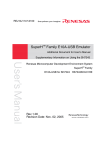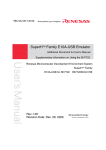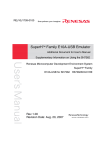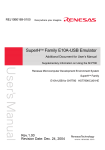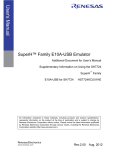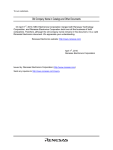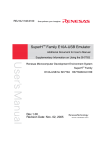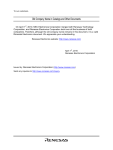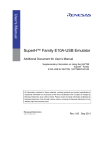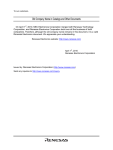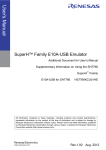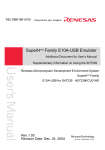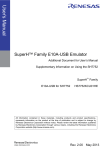Download Renesas SuperH SH7343 Technical information
Transcript
To our customers, Old Company Name in Catalogs and Other Documents On April 1st, 2010, NEC Electronics Corporation merged with Renesas Technology Corporation, and Renesas Electronics Corporation took over all the business of both companies. Therefore, although the old company name remains in this document, it is a valid Renesas Electronics document. We appreciate your understanding. Renesas Electronics website: http://www.renesas.com April 1st, 2010 Renesas Electronics Corporation Issued by: Renesas Electronics Corporation (http://www.renesas.com) Send any inquiries to http://www.renesas.com/inquiry. Notice 1. 2. 3. 4. 5. 6. 7. All information included in this document is current as of the date this document is issued. Such information, however, is subject to change without any prior notice. Before purchasing or using any Renesas Electronics products listed herein, please confirm the latest product information with a Renesas Electronics sales office. Also, please pay regular and careful attention to additional and different information to be disclosed by Renesas Electronics such as that disclosed through our website. Renesas Electronics does not assume any liability for infringement of patents, copyrights, or other intellectual property rights of third parties by or arising from the use of Renesas Electronics products or technical information described in this document. No license, express, implied or otherwise, is granted hereby under any patents, copyrights or other intellectual property rights of Renesas Electronics or others. You should not alter, modify, copy, or otherwise misappropriate any Renesas Electronics product, whether in whole or in part. Descriptions of circuits, software and other related information in this document are provided only to illustrate the operation of semiconductor products and application examples. You are fully responsible for the incorporation of these circuits, software, and information in the design of your equipment. Renesas Electronics assumes no responsibility for any losses incurred by you or third parties arising from the use of these circuits, software, or information. When exporting the products or technology described in this document, you should comply with the applicable export control laws and regulations and follow the procedures required by such laws and regulations. You should not use Renesas Electronics products or the technology described in this document for any purpose relating to military applications or use by the military, including but not limited to the development of weapons of mass destruction. Renesas Electronics products and technology may not be used for or incorporated into any products or systems whose manufacture, use, or sale is prohibited under any applicable domestic or foreign laws or regulations. Renesas Electronics has used reasonable care in preparing the information included in this document, but Renesas Electronics does not warrant that such information is error free. Renesas Electronics assumes no liability whatsoever for any damages incurred by you resulting from errors in or omissions from the information included herein. Renesas Electronics products are classified according to the following three quality grades: “Standard”, “High Quality”, and “Specific”. The recommended applications for each Renesas Electronics product depends on the product’s quality grade, as indicated below. You must check the quality grade of each Renesas Electronics product before using it in a particular application. You may not use any Renesas Electronics product for any application categorized as “Specific” without the prior written consent of Renesas Electronics. Further, you may not use any Renesas Electronics product for any application for which it is not intended without the prior written consent of Renesas Electronics. Renesas Electronics shall not be in any way liable for any damages or losses incurred by you or third parties arising from the use of any Renesas Electronics product for an application categorized as “Specific” or for which the product is not intended where you have failed to obtain the prior written consent of Renesas Electronics. The quality grade of each Renesas Electronics product is “Standard” unless otherwise expressly specified in a Renesas Electronics data sheets or data books, etc. “Standard”: 8. 9. 10. 11. 12. Computers; office equipment; communications equipment; test and measurement equipment; audio and visual equipment; home electronic appliances; machine tools; personal electronic equipment; and industrial robots. “High Quality”: Transportation equipment (automobiles, trains, ships, etc.); traffic control systems; anti-disaster systems; anticrime systems; safety equipment; and medical equipment not specifically designed for life support. “Specific”: Aircraft; aerospace equipment; submersible repeaters; nuclear reactor control systems; medical equipment or systems for life support (e.g. artificial life support devices or systems), surgical implantations, or healthcare intervention (e.g. excision, etc.), and any other applications or purposes that pose a direct threat to human life. You should use the Renesas Electronics products described in this document within the range specified by Renesas Electronics, especially with respect to the maximum rating, operating supply voltage range, movement power voltage range, heat radiation characteristics, installation and other product characteristics. Renesas Electronics shall have no liability for malfunctions or damages arising out of the use of Renesas Electronics products beyond such specified ranges. Although Renesas Electronics endeavors to improve the quality and reliability of its products, semiconductor products have specific characteristics such as the occurrence of failure at a certain rate and malfunctions under certain use conditions. Further, Renesas Electronics products are not subject to radiation resistance design. Please be sure to implement safety measures to guard them against the possibility of physical injury, and injury or damage caused by fire in the event of the failure of a Renesas Electronics product, such as safety design for hardware and software including but not limited to redundancy, fire control and malfunction prevention, appropriate treatment for aging degradation or any other appropriate measures. Because the evaluation of microcomputer software alone is very difficult, please evaluate the safety of the final products or system manufactured by you. Please contact a Renesas Electronics sales office for details as to environmental matters such as the environmental compatibility of each Renesas Electronics product. Please use Renesas Electronics products in compliance with all applicable laws and regulations that regulate the inclusion or use of controlled substances, including without limitation, the EU RoHS Directive. Renesas Electronics assumes no liability for damages or losses occurring as a result of your noncompliance with applicable laws and regulations. This document may not be reproduced or duplicated, in any form, in whole or in part, without prior written consent of Renesas Electronics. Please contact a Renesas Electronics sales office if you have any questions regarding the information contained in this document or Renesas Electronics products, or if you have any other inquiries. (Note 1) “Renesas Electronics” as used in this document means Renesas Electronics Corporation and also includes its majorityowned subsidiaries. (Note 2) “Renesas Electronics product(s)” means any product developed or manufactured by or for Renesas Electronics. User’s Manual SuperH™ Family E10A-USB Emulator Additional Document for User’s Manual Supplementary Information on Using the SH7343 Renesas Microcomputer Development Environment System SuperH™ Family E10A-USB for SH7343 HS7343KCU01HE Rev.1.00 2005.11 Keep safety first in your circuit designs! 1. Renesas Technology Corp. puts the maximum effort into making semiconductor products better and more reliable, but there is always the possibility that trouble may occur with them. Trouble with semiconductors may lead to personal injury, fire or property damage. Remember to give due consideration to safety when making your circuit designs, with appropriate measures such as (i) placement of substitutive, auxiliary circuits, (ii) use of nonflammable material or (iii) prevention against any malfunction or mishap. Notes regarding these materials 1. These materials are intended as a reference to assist our customers in the selection of the Renesas Technology Corp. product best suited to the customer's application; they do not convey any license under any intellectual property rights, or any other rights, belonging to Renesas Technology Corp. or a third party. 2. Renesas Technology Corp. assumes no responsibility for any damage, or infringement of any thirdparty's rights, originating in the use of any product data, diagrams, charts, programs, algorithms, or circuit application examples contained in these materials. 3. All information contained in these materials, including product data, diagrams, charts, programs and algorithms represents information on products at the time of publication of these materials, and are subject to change by Renesas Technology Corp. without notice due to product improvements or other reasons. It is therefore recommended that customers contact Renesas Technology Corp. or an authorized Renesas Technology Corp. product distributor for the latest product information before purchasing a product listed herein. The information described here may contain technical inaccuracies or typographical errors. Renesas Technology Corp. assumes no responsibility for any damage, liability, or other loss rising from these inaccuracies or errors. Please also pay attention to information published by Renesas Technology Corp. by various means, including the Renesas Technology Corp. Semiconductor home page (http://www.renesas.com). 4. When using any or all of the information contained in these materials, including product data, diagrams, charts, programs, and algorithms, please be sure to evaluate all information as a total system before making a final decision on the applicability of the information and products. Renesas Technology Corp. assumes no responsibility for any damage, liability or other loss resulting from the information contained herein. 5. Renesas Technology Corp. semiconductors are not designed or manufactured for use in a device or system that is used under circumstances in which human life is potentially at stake. Please contact Renesas Technology Corp. or an authorized Renesas Technology Corp. product distributor when considering the use of a product contained herein for any specific purposes, such as apparatus or systems for transportation, vehicular, medical, aerospace, nuclear, or undersea repeater use. 6. The prior written approval of Renesas Technology Corp. is necessary to reprint or reproduce in whole or in part these materials. 7. If these products or technologies are subject to the Japanese export control restrictions, they must be exported under a license from the Japanese government and cannot be imported into a country other than the approved destination. Any diversion or reexport contrary to the export control laws and regulations of Japan and/or the country of destination is prohibited. 8. Please contact Renesas Technology Corp. for further details on these materials or the products contained therein. Contents Section 1 Connecting the Emulator with the User System ................................1 1.1 1.2 1.3 1.4 1.5 Components of the Emulator ............................................................................................ 1 Connecting the Emulator with the User System ............................................................... 2 Installing the H-UDI Port Connector on the User System ................................................ 3 Pin Assignments of the H-UDI Port Connector ................................................................ 3 Recommended Circuit between the H-UDI Port Connector and the MPU....................... 6 1.5.1 Recommended Circuit (36-Pin Type) .................................................................. 6 1.5.2 Recommended Circuit (14-Pin Type) .................................................................. 8 Section 2 Software Specifications when Using the SH7343 .............................11 2.1 2.2 Differences between the SH7343 and the Emulator ......................................................... 11 Specific Functions for the Emulator when Using the SH7343.......................................... 16 2.2.1 Event Condition Functions .................................................................................. 16 2.2.2 Trace Functions.................................................................................................... 24 2.2.3 Notes on Using the JTAG (H-UDI) Clock (TCK) and AUD Clock (AUDCK)... 34 2.2.4 Notes on Setting the [Breakpoint] Dialog Box .................................................... 34 2.2.5 Notes on Setting the [Event Condition] Dialog Box and the BREAKCONDITION_ SET Command ........................................................ 36 2.2.6 Note on Setting the UBC_MODE Command ...................................................... 36 2.2.7 Note on Setting the PPC_MODE Command ....................................................... 36 2.2.8 Performance Measurement Function ................................................................... 37 i ii Section 1 Connecting the Emulator with the User System 1.1 Components of the Emulator The E10A-USB emulator supports the SH7343. Table 1.1 lists the components of the emulator. Table 1.1 Components of the Emulator Classification Component Hardware Appearance Quantity Emulator box 1 User system interface cable User system interface cable 1 USB cable 1 1 Remarks HS0005KCU01H: Depth: 65.0 mm, Width: 97.0 mm, Height: 20.0 mm, Mass: 72.9 g or HS0005KCU02H: Depth: 65.0 mm, Width: 97.0 mm, Height: 20.0 mm, Mass: 73.7 g 14-pin type: Length: 20 cm, Mass: 33.1 g 36-pin type: Length: 20 cm, Mass: 49.2 g (only for HS0005KCU02H) Length: 150 cm, Mass: 50.6 g Software E10A-USB emulator setup 1 HS0005KCU01SR, program, TM SuperH Family E10AHS0005KCU01HJ, USB Emulator User’s HS0005KCU01HE, Manual, Supplementary HS7343KCU01HJ, Information on Using the HS7343KCU01HE, SH7343*, and Test program manual for HS0005TM01HJ, and HS0005KCU01H and HS0005TM01HE HS0005KCU02H (provided on a CD-R) Note: Additional document for the MPUs supported by the emulator is included. Check the target MPU and refer to its additional document. 1 1.2 Connecting the Emulator with the User System To connect the E10A-USB emulator (hereinafter referred to as the emulator), the H-UDI port connector must be installed on the user system to connect the user system interface cable. When designing the user system, refer to the recommended circuit between the H-UDI port connector and the MPU. In addition, read the E10A-USB emulator user's manual and hardware manual for the related device. Table 1.2 shows the type number of the emulator, the corresponding connector type, and the use of AUD function. Table 1.2 Type Number, AUD Function, and Connector Type Type Number Connector AUD Function HS0005KCU02H 36-pin connector Available HS0005KCU01H, HS0005KCU02H 14-pin connector Not available The H-UDI port connector has the 36-pin and 14-pin types as described below. Use them according to the purpose of the usage. 1. 36-pin type (with AUD function) The AUD trace function is supported. A large amount of trace information can be acquired in realtime. The window trace function is also supported for acquiring memory access in the specified range (memory access address or memory access data) by tracing. 2. 14-pin type (without AUD function) The AUD trace function cannot be used because only the H-UDI function is supported. Since the 14-pin type connector is smaller than the 36-pin type (1/2.5), the area where the connector is installed on the user system can be reduced. 2 1.3 Installing the H-UDI Port Connector on the User System Table 1.3 shows the recommended H-UDI port connectors for the emulator. Table 1.3 Recommended H-UDI Port Connectors Connector Type Number Manufacturer Specifications 36-pin connector DX10M-36S Hirose Electric Co., Ltd. Screw type DX10M-36SE, DX10G1M-36SE 14-pin connector 2514-6002 Lock-pin type Minnesota Mining & Manufacturing Ltd. 14-pin straight type Note: When designing the 36-pin connector layout on the user board, do not connect any components under the H-UDI connector. When designing the 14-pin connector layout on the user board, do not place any components within 3 mm of the H-UDI port connector. 1.4 Pin Assignments of the H-UDI Port Connector Figures 1.1 and 1.2 show the pin assignments of the 36-pin and 14-pin H-UDI port connectors, respectively. Note: Note that the pin number assignments of the H-UDI port connector shown on the following pages differ from those of the connector manufacturer. 3 Pin No. Signal Input/ Output *1 1 AUDCK Output 2 GND 3 AUDATA0 4 GND 5 AUDATA1 6 GND 7 AUDATA2 8 GND 9 AUDATA3 Output Output Output Output SH7343 Pin No. Note Y13 AA14 V14 AB14 W13 Pin No. Signal Input/ Output*1 19 TMS Input W15 20 GND 21 /TRST *2 Input W14 22 (GND) *4 23 TDI Input V15 24 GND 25 TDO Output Y14 26 GND 27 /ASEBRK / *2 BRKACK Input/ output AA13 28 GND Output V16 Output Output Output V16 AB17 E11 10 GND 11 /AUDSYNC *2 Output 29 UVCC 12 GND 30 GND 13 N.C. 31 /RESETP *2 /RESETA /RESETMFI V13 14 GND 32 GND 15 N.C. 33 GND *3 16 GND 34 GND 17 TCK 18 GND Input AB15 35 N.C. 36 GND SH7343 Pin No. Note User reset *5 Output Notes: 1. Input to or output from the user system. 2. The symbol (/) means that the signal is active-low. 3. The emulator monitors the GND signal of the user system and detects whether or not the user system is connected. 4. When the user system interface cable is connected to this pin and the MPMD pin is set to 0, do not connect to GND but to the MPMD pin directly. 5. Connect /RESETP, /RESETA, and /RESETMFI to the user system if required, as shown in figure 1.3. H-UDI port connector (top view) Edge of the board (connected to the connector) φ 0.7+0.1 0 36 1 3 9.0 1.905 1.1 4.5 2 φ 2.8+0.2 0 4 (Pin 1 mark) 35 1.27 4.09 M2.6 x 0.45 H-UDI port connector (front view) 4.8 H-UDI port connector (top view) 3.9 37.61 43.51 : Pattern inhibited area 0.3 9.0 21.59 Unit: mm Figure 1.1 Pin Assignments of the H-UDI Port Connector (36 Pins) 4 SH7343 Pin No. Signal Input/ Output*1 1 TCK Input AB15 2 /TRST Input W14 Output Y14 Input/ AA13 Pin No. 3 *2 TDO 4 /ASEBRK / 5 6 7 *2 BRKACK output TMS Input W15 TDI Input V15 Output V16 /RESETA Output AB17 /RESETMFI Output E11 /RESETP 8 N.C. 9 (GND) 11 UVCC 10, 12, GND *2 Note User reset *5 *4 Output and 13 14 GND *3 Output Notes: 1. Input to or output from the user system. 2. The symbol (/) means that the signal is active-low. 3. The emulator monitors the GND signal of the user system and detects whether or not the user system is connected. 4. When the user system interface cable is connected to this pin and the MPMD pin is set to 0, do not connect to GND but to the MPMD pin directly. 5. Connect /RESETP, /RESETA, and /RESETMFI to the user system if required, as shown in figure 1.4. Pin 1 mark H-UDI port connector (top view) 25.0 23.0 6 x 2.54 = 15.24 (2.54) H-UDI port connector (top view) Pin 8 Pin 1 Pin 14 Pin 7 0.45 Pin 1 mark Unit: mm Figure 1.2 Pin Assignments of the H-UDI Port Connector (14 Pins) 5 1.5 Recommended Circuit between the H-UDI Port Connector and the MPU 1.5.1 Recommended Circuit (36-Pin Type) Figure 1.3 shows a recommended circuit for connection between the H-UDI and AUD port connectors (36 pins) and the MPU when the emulator is in use. Notes: 1. Do not connect anything to the N.C. pins of the H-UDI port connector. 6 2. The MPMD pin must be 0 when the emulator is connected and 1 when the emulator is not connected, respectively. (1) When the emulator is used: MPMD = 0 (2) When the emulator is not used: MPMD = 1 Figures 1.3 shows an examples of circuits that allow the MPMD pin to be GND (0) whenever the emulator is connected by using the user system interface cable. 3. When a network resistance is used for pull-up, it may be affected by a noise. Separate TCK from other resistances. 4. The /TRST pin must be at the low level for a certain period when the power is supplied whether the H-UDI is used or not. Reduce the power supplied to the /TRST pin by pulling the pin down by a resistance of 1 kilo-ohm and setting PUL15 = 0 in the PULCR register after a reset. 5. The pattern between the H-UDI port connector and the MPU must be as short as possible. Do not connect the signal lines to other components on the board. 6. Since the H-UDI and the AUD of the MPU operate with the VccQ, supply only the VccQ to the UVCC pin. Make the emulator’s switch settings so that the user power will be supplied (SW2 = 1 and SW3 = 1). 7. The resistance values shown in figure 1.3 are reference. 8. For the pin processing in cases where the emulator is not used, refer to the hardware manual of the related MPU. 9. For the AUDCK pin, guard the pattern between the H-UDI port connector and the MPU at GND level. When the circuit is connected as shown in figure 1.3, the switches of the emulator are set as SW2 TM = 1 and SW3 = 1. For details, refer to section 3.8, Setting the DIP Switches, in the SuperH Family E10A-USB Emulator User’s Manual. VccQ = 2.85-V I/O power supply All pulled-up at 4.7 kΩ or more VccQ VccQ VccQ VccQ VccQ VccQ H-UDI port connector (36-pin type) 2 4 6 8 10 12 14 16 18 20 22 24 26 28 30 32 34 36 GND AUDCK GND AUDATA0 GND AUDATA1 GND AUDATA2 GND AUDATA3 GND AUDSYNC GND N.C. GND GND GND (GND) GND GND GND GND GND GND GND SH7343 1 5 AUDATA2 AUDATA3 11 AUDSYNC 13 15 17 TMS 19 TDO AUDATA1 9 N.C. TDI AUDATA0 7 TCK TRST AUDCK 3 TCK TMS 21 TRST 23 TDI 25 ASEBRK 27 / BRKACK 29 UVCC 31 RESET 33 GND 35 N.C. TDO ASEBRK /BRKACK 1 kΩ *2 *2 Levelshift circuit *3 RESETP *1 RESETA RESETMFI MPMD Power-on reset signal Reset signal MFI reset signal User system Figure 1.3 Recommended Circuit for Connection between the H-UDI Port Connector and MPU when the Emulator is in Use (36-Pin Type) Notes: 1. Do not use /RESETP in the emulator after the user system has been activated. When reset signals are used for debugging, use /RESETA or /RESETMFI. 2. Fix /RESETA and /RESETMFI as high levels when they are not used. 3. When VccQ_MFI is used at 1.8 V, the level-shift circuit in figure 1.3 is required to adjust the signal levels. 7 1.5.2 Recommended Circuit (14-Pin Type) Figure 1.4 shows a recommended circuit for connection between the H-UDI and AUD port connectors (14 pins) and the MPU when the emulator is in use. Notes: 1. Do not connect anything to the N.C. pins of the H-UDI port connector. 8 2. The MPMD pin must be 0 when the emulator is connected and 1 when the emulator is not connected, respectively. (1) When the emulator is used: MPMD = 0 (2) When the emulator is not used: MPMD = 1 Figures 1.3 shows an examples of circuits that allow the MPMD pin to be GND (0) whenever the emulator is connected by using the user system interface cable. 3. When a network resistance is used for pull-up, it may be affected by a noise. Separate TCK from other resistances. 4. The /TRST pin must be at the low level for a certain period when the power is supplied whether the H-UDI is used or not. Reduce the power supplied to the /TRST pin by pulling the pin down by a resistance of 1 kilo-ohm and setting PUL15 = 0 in the PULCR register after a reset. 5. The pattern between the H-UDI port connector and the MPU must be as short as possible. Do not connect the signal lines to other components on the board. 6. Since the H-UDI of the MPU operates with the VccQ, supply only the VccQ to the UVCC pin. Make the emulator’s switch settings so that the user power will be supplied (SW2 = 1 and SW3 = 1). 7. The resistance values shown in figure 1.4 are reference. 8. For the pin processing in cases where the emulator is not used, refer to the hardware manual of the related MPU. When the circuit is connected as shown in figure 1.4, the switches of the emulator are set as SW2 TM = 1 and SW3 = 1. For details, refer to section 3.8, Setting the DIP Switches, in the SuperH Family E10A-USB Emulator User’s Manual. VccQ = 2.85-V I/O power supply VccQ VccQ VccQ All pulled-up at 4.7 kΩ or more VccQ VccQ VccQ H-UDI port connector (14-pin type) TCK 9 (GND) 10 GND 12 13 GND GND 14 GND TRST TDO SH7343 1 TCK 2 TRST 3 TDO ASEBRK 4 / BRKACK 5 TMS 6 TDI RESET N.C. UVCC ASEBRK/BRKACK TMS TDI 7 8 11 1 kΩ *2 *2 Levelshift circuit *3 RESETP *1 RESETA RESETMFI MPMD Power-on reset signal Reset signal MFI reset signal User system Figure 1.4 Recommended Circuit for Connection between the H-UDI Port Connector and MPU when the Emulator is in Use (14-Pin Type) Notes: 1. Do not use /RESETP in the emulator after the user system has been activated. When reset signals are used for debugging, use /RESETA or /RESETMFI. 2. Fix /RESETA and /RESETMFI as high levels when they are not used. 3. When VccQ_MFI is used at 1.8 V, the level-shift circuit in figure 1.4 is required to adjust the signal levels. 9 10 Section 2 Software Specifications when Using the SH7343 2.1 Differences between the SH7343 and the Emulator 1. When the emulator system is initiated, it initializes the general registers and part of the control registers as shown in table 2.1. The initial values of the actual SH7343 registers are undefined. When the emulator is initiated from the workspace, a value to be entered is saved in a session. Table 2.1 Register Initial Values at Emulator Link Up Register Emulator at Link Up R0 to R14 H'00000000 R15 (SP) H'A0000000 R0_BANK to R7_BANK H'00000000 PC H'A0000000 SR H'700000F0 GBR H'00000000 VBR H'00000000 MACH H'00000000 MACL H'00000000 PR H'00000000 SPC H'00000000 SSR H'000000F0 RS H'00000000 RE H'00000000 MOD H'00000000 A0G, A1G H'00000000 A0, A1 H'00000000 X0, X1 H'00000000 Y0, Y1 H'00000000 M0, M1 H'00000000 DSR H'00000000 2. The emulator uses the H-UDI; do not access the H-UDI. 11 3. Low-Power States (Sleep, Software Standby, Module Standby, U Standby, and R Standby) For low-power consumption, the SH7343 has sleep, software standby, module standby, U standby, and R standby states. The sleep, software standby, and module standby states are switched using the SLEEP instruction. When the emulator is used, the sleep and software standby states can be cleared with either the normal clearing function or with the [STOP] button, and a break will occur. Note: The memory must not be accessed or modified in sleep state. 4. Reset Signals The SH7343 reset signals are only valid during emulation started with clicking the GO or STEP-type button. If these signals are enabled on the user system in command input wait state, they are not sent to the SH7343. Note: Do not break the user program when the /RESETA, /RESETMFI, or /BREQ signal is being low and the wait control signal is being active. A TIMEOUT error will occur. If the wait control signal becomes active or the /BREQ signal is fixed to low during break, a TIMEOUT error will occur at memory access. 5. Direct Memory Access Controller (DMAC) The DMAC operates even when the emulator is used. When a data transfer request is generated, the DMAC executes DMA transfer. 6. Memory Access during User Program Execution When a memory is accessed from the memory window, etc. during user program execution, the user program is resumed after it has stopped in the E10A-USB emulator to access the memory. Therefore, realtime emulation cannot be performed. The stopping time of the user program is as follows: Environment: ® Host computer: 800 MHz (Pentium III) JTAG clock: 10 MHz (TCK clock) When a one-byte memory is read from the command-line window, the stopping time will be about 42 ms. 7. Memory Access during User Program Break The emulator can download the program for the flash memory area (for details, refer to section TM 6.22, Download Function to the Flash Memory Area, in the SuperH Family E10A-USB Emulator User’s Manual). Other memory write operations are enabled for the RAM area. Therefore, an operation such as memory write or BREAKPOINT should be set only for the RAM area. 12 8. Cache Operation during User Program Break When cache is enabled, the emulator accesses the memory by the following methods: • At memory write: Writes through the cache, then issues a single write to outside. The LRU is not updated. • At memory read: Reads memory from the cache. The LRU is not updated. Therefore, when memory read or write is performed during user program break, the cache state does not change. • At breakpoint set: Disables the instruction cache. 9. Port G The AUD pin is multiplexed as shown in table 2.2. Table 2.2 Multiplexed Functions Port Function 1 Function 2 G PTG4 input/output (port)* AUDSYNC (AUD) G PTG3 input/output (port)* AUDATA3 (AUD) G PTG2 input/output (port)* AUDATA2 (AUD) G PTG1 input/output (port)* AUDATA1 (AUD) G PTG0 input/output (port)* AUDATA0 (AUD) Note: Function 1 can be used when the AUD pins of the device are not connected to the emulator. 10. UBC When [User] is specified in the [UBC mode] list box in the [Configuration] dialog box, the UBC can be used in the user program. Do not use the UBC in the user program as it is used by the emulator when [EML] is specified in the [UBC mode] list box in the [Configuration] dialog box. 11. MFI When the MFI boot mode is used, be sure to activate the emulator by setting the MFIINT signal as a trigger for the MFI transfer from the base-band side. In the active-through mode, the emulator does not operate during break. 13 12. Memory Access during Break In the enabled MMU, when a memory is accessed and a TLB error occurs during break, it can be selected whether the TLB exception is controlled or the program jumps to the user exception handler in [TLB Mode] in the [Configuration] dialog box. When [TLB miss exception is enable] is selected, a “Communication Timeout error” will occur if the TLB exception handler does not operate correctly. When [TLB miss exception is disable] is selected, the program does not jump to the TLB exception handler even if a TLB exception occurs. Therefore, if the TLB exception handler does not operate correctly, a “Communication Timeout error” will not occur but the memory contents may not be correctly displayed. 13. Loading Sessions Information in [JTAG clock] of the [Configuration] dialog box cannot be recovered by loading sessions. Thus the TCK value will be 1.25 MHz. 14. [IO] window • Display and modification Do not change values of the User Break Controller because it is used by the emulator. For each RCLK watchdog timer register, there are two registers to be separately used for write and read operations. Table 2.3 RCLK Watchdog Timer Register Register Name Usage Register RWTCSR(W) Write RCLK watchdog timer control/status register RWTCNT(W) Write RCLK watchdog timer counter RWTCSR(R) Read RCLK watchdog timer control/status register RWTCNT(R) Read RCLK watchdog timer counter • The RCLK watchdog timer operates only when the user program is executed. Do not change the value of the frequency change register in the [IO] window or [Memory] window. • The internal I/O registers can be accessed from the [IO] window. However, note the following when accessing the SDMR register of the bus-state controller. Before accessing the SDMR register, specify addresses to be accessed in the I/O-register definition file (SH7343.IO) and then activate the HEW. After the I/O-register definition file is created, the MPU’s specifications may be changed. If each I/O register in the I/O-register definition file differs from addresses described in the hardware manual, change the I/Oregister definition file according to the description in the hardware manual. The I/Oregister definition file can be customized depending on its format. Note that, however, the E10A emulator does not support the bit-field function. 14 • Verify In the [IO] window, the verify function of the input value is disabled. 15. Illegal Instructions If illegal instructions are executed by STEP-type commands, the emulator cannot go to the next program counter. 16. [Reset CPU] and [Reset Go] in the [Debug] Menu When a reset is issued from [Reset CPU] or [Reset Go] in the [Debug] menu, the clock pulse generator or watchdog timer is not initialized. 15 2.2 Specific Functions for the Emulator when Using the SH7343 2.2.1 Event Condition Functions The emulator is used to set 12 event conditions (Ch1 to Ch12) and the software trace. Table 2.4 lists the conditions of Event Condition. Table 2.4 Types of Event Conditions Event Condition Type Description Address bus condition (Address) Breaks when the SH7343 address bus value or the program counter value matches the specified value. Data bus condition (Data) Breaks when the SH7343 data bus value matches the specified value. Byte, word, or longword can be specified as the access data size. Bus state condition (Bus State) There are two bus state condition settings: Bus state condition: Breaks or acquires a trace when the data bus or the X-Bus or Y-Bus address bus of the SH7343 is matched. Read/Write condition: Breaks or acquires a trace when the specified read/write condition is matched. Window address condition Breaks or acquires a trace when the data in the specified memory range is accessed. System bus Breaks or acquires a trace when the address or data on the system bus is matched. LDTLB instruction event condition Breaks when the SH7343 executes the LDTLB instruction. Count Breaks when the conditions set are satisfied the specified number of times. Branch trace condition (Branch trace) Breaks or acquires a trace when a branch occurs with the condition specified by the SH7343. (By default, trace acquisition is enabled). Software trace Selects whether or not the software trace is acquired. Action Selects the operation when a condition, such as setting a break, trace, or performance start or end, is matched. Table 2.5 lists the combinations of conditions that can be set under Ch1 to Ch12 and the software trace. 16 Table 2.5 Dialog Boxes for Setting Event Conditions Function Address Data Bus Bus ASID Bus Window State Address Branch Condition Condition LDTLB Count Condition Dialog Condition Condition Condition (Bus (Window System Instruction Condition (Branch Software Box (Address) (Data) address) Bus Trace) Trace X X [Event O X (ASID) O Status) O X Break X X (Count) X Action O Condition (B and 1] dialog P) box [Event O O O O X X X O X X O Condition (B and 2] dialog P) box [Event O X O X X X X X X X O Condition (B and 3] dialog P) box [Event O X O X X X X X X X O Condition (B and 4] dialog P) box [Event X X O O O X X X X X O Condition (B, T, 5] dialog and P) box [Event X X O O O X X X X X O Condition (B, T, 6] dialog and P) box [Event X X X X X X O X X X Condition Break fixed 7] dialog box [Event O X X X X O X X X X O Condition (B, T, 8] dialog and P) box 17 Table 2.5 Dialog Boxes for Setting Event Conditions (cont) Function Address Data Bus Bus ASID Bus Window State Address Branch Condition Condition LDTLB Count Condition Dialog Condition Condition Condition (Bus (Window System Instruction Condition (Branch Software Box (Address) (Data) address) Bus Trace) Trace X X [Event O (ASID) X Status) X X X Break O X (Count) X Action O Condition (B, T, 9] dialog and P) box [Event O X O O X X X X X X O Condition (B and 10] dialog P) box [Event O O O O X X X O X X O Condition (B and 11] dialog P) box [Event X X X X X X X X O X O Condition (B, T, 12] dialog and P) box [Software X X X X X X trace] box 1. O: Can be set in the dialog box. X: Cannot be set in the dialog box. 2. For the Action item, B: Setting a break is enabled. T: Setting a trace is enabled. P: Setting a performance start or end condition is enabled. 18 X X O Trace fixed dialog Notes: X Sequential Setting: In the emulator, sequential setting of an Event Condition is enabled. Table 2.6 Sequential Event Conditions Type Event Condition Description [CPU 2 Channel Ch2 -> 1 Sequential Sequential Event] Page Halts a program when a condition is satisfied in the order of Event Condition 2, 1. An event condition must be set for Ch2 and Ch1. Ch4 -> 3 Halts a program when a condition is satisfied in the order of Event Condition 4, 3. An event condition must be set for Ch4 and Ch3. Ch6 -> 5 Halts a program when a condition is satisfied in the order of Event Condition 6, 5. An event condition must be set for Ch6 and Ch5. Ch11 -> 10 Halts a program when a condition is satisfied in the order of Event Condition 11, 10. An event condition must be set for Ch11 and Ch10. Many Ch3 -> 2 -> 1 Channel Sequential Ch4 -> 3-> 2 -> 1 Halts a program when a condition is satisfied in the order of Event Condition 3, 2, 1. An event condition must be set for Ch3, Ch2, and Ch1. Halts a program when a condition is satisfied in the order of Event Condition 4, 3, 2, 1. An event condition must be set for Ch4, Ch3, Ch2, and Ch1. Ch5 -> 4 -> 3-> 2 -> 1 Halts a program when a condition is satisfied in the order of Event Condition 5, 4, 3, 2, 1. An event condition must be set for Ch5, Ch4, Ch3, Ch2, and Ch1. Ch6 -> 5 -> 4 -> 3-> 2 Halts a program when a condition is satisfied in the -> 1 order of Event Condition 6, 5, 4, 3, 2, 1. An event condition must be set for Ch6, Ch5, Ch4, Ch3, Ch2, and Ch1. Ch10 -> 6 -> 5 -> 4 -> Halts a program when a condition is satisfied in the 3-> 2 -> 1 order of Event Condition 10, 6, 5, 4, 3, 2, 1. An event condition must be set for Ch10, Ch6, Ch5, Ch4, Ch3, Ch2, and Ch1. Ch11 -> 10 -> 6 -> 5 -> Halts a program when a condition is satisfied in the 4 -> 3-> 2 -> 1 order of Event Condition 11, 10, 6, 5, 4, 3, 2, 1. An event condition must be set for Ch11, Ch10, Ch6, Ch5, Ch4, Ch3, Ch2, and Ch1. 19 Table 2.6 Sequential Event Conditions (cont) Type Event Condition Description [CPU CPU Extend Sequential Event] Page (cont) Expands the [CPU Sequential Extend] page. The sequential setting is enabled with any combination. For details, refer to section 2.2.1, Sequential Break Extension Setting, in this manual. [SystemBus SystemBus Ch9 -> 8 Sequential Sequential Event] Page Event Halts a program when a condition is satisfied for Event Condition 9, 8. An event condition must be set for Ch9 and Ch8. Ch8 -> 9 Halts a program when a condition is satisfied for Event Condition 8, 9. An event condition must be set for Ch8 and Ch9. SystemBus Extend 20 Expands the [SystemBus Sequential Extend] page. The sequential setting is enabled with any combination. For details, refer to section 2.2.1, Sequential Break Extension Setting, in this manual. Sequential Break Extension Setting: Figure 2.1 [CPU Sequential Extend] Page (a) Indicates the channel name for setting conditions. (b) Selects a condition that is satisfied before the channel which sets up conditions. When a channel name is selected, it is required that the condition of the channel selected here must have already been satisfied. When [CPU Match flag] is selected, the CPU match flag must be set. When a condition is selected by the channel selected here, no break will occur. (c) When a condition is satisfied, the CPU match flag is set or cleared. When a program breaks, the CPU match flag is initialized. Set the event condition for each channel in the [Event Condition] dialog box; this also applies to the [SystemBus Sequential Extend] page. 21 Usage Example of Sequential Break Extension Setting: A tutorial program provided for the product is used as an example. For the tutorial program, refer to section 6, Tutorial, in the TM SuperH Family E10A-USB Emulator User’s Manual. The conditions of Event Condition are set as follows: 1. Ch1 Breaks address H’00001068 when the condition [Prefetch address break after executing] is satisfied. 2. Ch2 Breaks address H’00001058 when the condition [Prefetch address break after executing] is satisfied. 3. Ch4 Breaks address H’0000107a when the condition [Prefetch address break after executing] is satisfied. 4. Ch10 Breaks address H’00001086 when the condition [Prefetch address break after executing] is satisfied. Note: Do not set other channels. 5. Set the [CPU Sequential Extend] page as shown in figure 2.1. Then, set the program counter and stack pointer (PC = H’00000800, R15 = H’00010000) in the [Registers] window and click the [Go] button. If this does not execute normally, issue a reset and execute the above procedures. The program is executed up to the condition of Ch10 and halted. Here, the condition is satisfied in the order of Ch2 -> 1 -> 4 -> 10. 22 Figure 2.2 [Source] Window at Execution Halted (Sequential Break) 23 2.2.2 Trace Functions The emulator supports the trace functions listed in table 2.7. Table 2.7 Trace Functions Function Internal Trace AUD Trace Memory Output Trace Branch trace Supported (eight branches) Supported Supported Range memory access trace Supported (eight events) Supported Supported Software trace Supported (eight events) Supported Supported Table 2.8 shows the type numbers that the AUD function can be used. Table 2.8 Type Number and AUD Function Type Number AUD Function HS0005KCU01H Not supported HS0005KCU02H Supported 24 Branch Trace Functions: The branch source and destination addresses, their source lines, branch types, and types of accessed bus masters are displayed. [Setting Method] Select the check box in the [Branch] group box in the [Branch trace] page of the [Branch trace] dialog box that opens by double-clicking on the Ch12 (Branch) column of the [Eventpoint] window. The branch condition to be acquired can be set. Figure 2.3 [Branch trace] Dialog Box A branch trace can be acquired by selecting the [Acquire trace] check box of the [Action] page. Note: To cancel settings, select [Delete] from the popup menu that is opened by clicking on the Ch12 (Branch) column with the right-mouse button. 25 Range Memory Access Trace Functions: The memory access within the specified range is acquired by a trace. The read cycle, write cycle, or read/write cycle can be selected as the bus type, ASID value, or bus cycle for trace acquisition. [Setting Method] (i) To open the [Event condition 5] or [Event condition 6] dialog box, double-click on the Ch5 (OA) or Ch6 (OA) column of the [Eventpoint] window. (ii) Remove the check mark of the [Don’t care] check box in the [Window address] page and enter the memory range to be set. Figure 2.4 [Window address] Page 26 (iii) Open the [ASID] page, remove the check mark of the [Don’t care] check box, and enter the ASID value to be set. When the ASID value is not set as a condition, do not remove the check mark of the [Don’t care] check box. (iv) Open the [Bus state] page and specify the bus type and bus cycle that are to be set. Figure 2.5 [Bus State] Page (v) Selecting the [Acquire trace] check box in the [Action] page enables acquiring memory access within the range. Note: To cancel settings, select the popup menu that is opened by clicking on the Ch5 (OA) or Ch6 (OA) column with the right-mouse button. 27 Software Trace Function: Note: This function can be supported with SHC/C++ compiler (manufactured by Renesas Technology Corp.; including OEM and bundle products) V6.0 or later. However, SHC/C++ compiler (including OEM and bundle products) V8.0 or later is needed when instructions other than those compatible with SH4 are output. When a specific instruction is executed, the PC value at execution and the contents of one general register are acquired by trace. Describe the Trace(x) function (x is a variable name) to be TM compiled and linked beforehand. For details, refer to the SuperH RISC engine C/C++ Compiler, Assembler, Optimizing Linkage Editor User’s Manual. When the load module is downloaded on the emulator and is executed while a software trace function is valid, the PC value that has executed the Trace(x) function, the general register value for x, and the source lines are displayed. To activate the software trace function, select the [Acquire Software trace] radio button in the [Software trace] dialog box that is opened by double-clicking on the software Trace column of the [Eventpoint] window. Note: To cancel settings, select the [Don’t care] radio button in the [Software trace] dialog box or select [Delete] from the popup menu that is opened by clicking on the software Trace column with the right-mouse button. Internal Trace Function: This function is activated by selecting the [Internal trace] radio button in the [Trace type] group box of the [Trace mode] page. Set the trace condition to be used. Notes: 1. If an interrupt is generated at the program execution start or end, including a step operation, the emulator address may be acquired. In such a case, the following message will be displayed. Ignore this address because it is not a user program address. *** EML *** 2. If a completion-type exception occurs during exception branch acquisition, the next address to the address in which an exception occurs is acquired. 3. Trace information cannot be acquired for the following branch instructions: • The BF and BT instructions whose displacement value is 0 • Branch to H'A0000000 by reset 28 AUD Trace Functions: This function is operational when the AUD pin of the device is connected to the emulator. It is activated by selecting the [AUD trace] radio button in the [Trace type] group box of the [Trace mode] page. Set the trace condition to be used. Table 2.9 shows the AUD trace acquisition mode that can be set in each trace function. Table 2.9 AUD Trace Acquisition Mode Type Mode Description Continuous trace occurs Realtime trace When the next branch occurs while the trace information is being output, all the information may not be output. The user program can be executed in realtime, but some trace information will be lost. Non realtime trace When the next branch occurs while the trace information is being output, the CPU stops operations until the information is output. The user program is not executed in realtime. Trace continue This function overwrites the oldest trace information to store the latest trace information. Trace stop After the trace buffer becomes full, the trace information is no longer acquired. The user program is continuously executed. Trace buffer full 29 To set the AUD trace acquisition mode, click the [Trace] window with the right mouse button and select [Setting] from the pop-up menu to display the [Acquisition] dialog box. The AUD trace acquisition mode can be set in the [Trace Mode 1] or [Trace Mode 2] group box in the [Trace Mode] page of the [Acquisition] dialog box. Figure 2.6 [Trace Mode] Page 30 Notes on AUD Trace: 1. When the trace display is performed during user program execution, the mnemonics, operands, or source is not displayed. 2. The AUD branch trace function outputs the differences between newly output branch source addresses and previously output branch source addresses. The window trace function outputs the differences between newly output addresses and previously output addresses. If the previously output address is the same as the upper 16 bits, the lower 16 bits are output. If it matches the upper 24 bits, the lower 8 bits are output. If it matches the upper 28 bits, the lower 4 bits are output. The emulator regenerates the 32-bit address from these differences and displays it in the [Trace] window. If the emulator cannot display the 32-bit address, it displays the difference from the previously displayed 32-bit address. 3. If the 32-bit address cannot be displayed, the source line is not displayed. 4. In the emulator, when multiple loops are performed to reduce the number of AUD trace displays, only the IP counts up. 5. In the emulator, the maximum number of trace displays is 65534 lines (32767 branches). However, the maximum number of trace displays differs according to the AUD trace information to be output. Therefore, the above pointers cannot be always acquired. 6. The AUD trace acquisition is not available when [User] is selected in the [UBC mode] list box of the [Configuration] dialog box. In this case, close the [Trace] window. 7. Do not use the AUD full-trace mode for the VIO function. 8. If a completion-type exception occurs during exception branch acquisition, the next address to the address in which an exception occurs is acquired. 31 Memory Output Trace Functions: This function is activated by selecting the [Use Memory trace] radio button in the [Trace type] group box of the [Trace mode] page. In this function, write the trace data in the specified user memory range. Specify the start address to output a trace for the [Start] edit box in the [User memory area] group box, and the end address for the [End Address] edit box. Set the trace condition to be used. Table 2.10 shows the memory-output trace acquisition mode that can be set in each trace function. Table 2.10 Memory-Output Trace Acquisition Mode Type Mode Description Continuous trace occurs Realtime trace When the next branch occurs while the trace information is being output, all the information may not be output. The user program can be executed in realtime, but some trace information will be lost. Non realtime trace When the next branch occurs while the trace information is being output, the CPU stops operations until the information is output. The user program is not executed in realtime. Trace continue This function overwrites the oldest trace information to store the latest trace information. Trace stop After the trace buffer becomes full, the trace information is no longer acquired. The user program is continuously executed. Trace buffer full 32 To set the memory-output trace acquisition mode, click the [Trace] window with the right mouse button and select [Setting] from the pop-up menu to display the [Acquisition] dialog box. The AUD trace acquisition mode can be set in the [Trace Mode 1] or [Trace Mode 2] group box in the [Trace Mode] page of the [Acquisition] dialog box. Figure 2.7 [Trace Mode] Page 33 Notes: 1. The memory range for which trace is output is the address on the system bus and not supported for the MMU or cache. 2. In the memory range for output, do not specify the ranges that the user program has been downloaded or the user program accesses. 3. The range for trace output must be 1 MB or less. 2.2.3 Notes on Using the JTAG (H-UDI) Clock (TCK) and AUD Clock (AUDCK) 1. Set the JTAG clock (TCK) frequency to lower than the frequency of the SH7343 peripheral module clock (CKP). 2. Set the AUD clock (AUDCK) frequency to 50 MHz or lower. If the frequency is higher than 50 MHz, the emulator will not operate normally. 3. The set value of the JTAG clock (TCK) is initialized by executing [Reset CPU] or [Reset Go]. 2.2.4 Notes on Setting the [Breakpoint] Dialog Box 1. When an odd address is set, the next lowest even address is used. 2. A BREAKPOINT is accomplished by replacing instructions of the specified address. Accordingly, it can be set only to the RAM areas in CS0 to CS6 and the internal RAM areas. However, a BREAKPOINT cannot be set to the following addresses: • ROM areas in CS0 to CS6 • Areas other than the internal RAM • Areas other than CS0 to CS6 • A slot instruction of a delayed branch instruction • An area that can be only read by MMU 3. During step operation, BREAKPOINTs are disabled. 4. When execution resumes from the address where a BREAKPOINT is specified, single-step operation is performed at the address before execution resumes. Therefore, realtime operation cannot be performed. 5. When a BREAKPOINT is set to the slot instruction of a delayed branch instruction, the PC value becomes an illegal value. Accordingly, do not set a BREAKPOINT to the slot instruction of a delayed branch instruction. 6. Note on DSP repeat loop: A BREAKPOINT is equal to a branch instruction. In some DSP repeat loops, branch instructions cannot be set. For these cases, do not set BREAKPOINTs. Refer to the hardware manual for details. 7. When the [Normal] option is selected in the [Memory area] group box in the [General] page of the [Configuration] dialog box, a BREAKPOINT is set to a physical address or a virtual address according to the SH7343 MMU status during command input when the VPMAP_SET 34 command setting is disabled. The ASID value of the SH7343 PTEH register during command input is used. When VPMAP_SET command setting is enabled, a BREAKPOINT is set to a physical address into which address translation is made according to the VP_MAP table. However, for addresses out of the range of the VP_MAP table, the address to which a BREAKPOINT is set depends on the SH7343 MMU status during command input. Even when the VP_MAP table is modified after BREAKPOINT setting, the address translated when the BREAKPOINT is set valid. 8. When the [Physical] option is selected in the [Memory area] group box in the [General] page of the [Configuration] dialog box, a BREAKPOINT is set to a physical address. A BREAKPOINT is set after disabling the SH7343 MMU upon program execution. After setting, the MMU is returned to the original state. When a break occurs at the corresponding virtual address, the cause of termination displayed in the status bar and the [Output] window is ILLEGAL INSTRUCTION, not BREAKPOINT. 9. When the [Virtual] option is selected in the [Memory area] group box in the [General] page of the [Configuration] dialog box, a BREAKPOINT is set to a virtual address. A BREAKPOINT is set after enabling the SH7343 MMU upon program execution. After setting, the MMU is returned to the original state. When an ASID value is specified, the BREAKPOINT is set to the virtual address corresponding to the ASID value. The emulator sets the BREAKPOINT after rewriting the ASID value to the specified value, and returns the ASID value to its original value after setting. When no ASID value is specified, the BREAKPOINT is set to a virtual address corresponding to the ASID value at command input. 10. An address (physical address) to which a BREAKPOINT is set is determined when the BREAKPOINT is set. Accordingly, even if the VP_MAP table is modified after BREAKPOINT setting, the BREAKPOINT address remains unchanged. When a BREAKPOINT is satisfied with the modified address in the VP_MAP table, the cause of termination displayed in the status bar and the [Output] window is ILLEGAL INSTRUCTION, not BREAKPOINT. 11. If an address of a BREAKPOINT cannot be correctly set in the ROM or flash memory area, a mark z will be displayed in the [BP] area of the address on the [Source] or [Disassembly] window by refreshing the [Memory] window, etc. after Go execution. However, no break will occur at this address. When the program halts with the event condition, the mark z disappears. 35 2.2.5 Notes on Setting the [Event Condition] Dialog Box and the BREAKCONDITION_ SET Command 1. When [Go to cursor], [Step In], [Step Over], or [Step Out] is selected, the settings of Event Condition 3 are disabled. 2. When an Event Condition is satisfied, emulation may stop after two or more instructions have been executed. 3. If a PC break address condition is set to the slot instruction after a delayed branch instruction, user program execution cannot be terminated before the slot instruction execution; execution stops before the branch destination instruction. 2.2.6 Note on Setting the UBC_MODE Command In the [Configuration] dialog box, if [User] is set while the [UBC mode] list box has been set, Ch10 (IA_OA_R) and Ch11 (OA_OA_CT_R) of Event Condition cannot be used. 2.2.7 Note on Setting the PPC_MODE Command In the [Configuration] dialog box, if [User] is set while the [PPC mode] list box has been set, Ch1 and Ch2 of the performance analysis function and options 1 and 2 of the profile function cannot be used. 36 2.2.8 Performance Measurement Function The emulator supports the performance measurement function. 1. Setting the performance measurement conditions To set the performance measurement conditions, use the [Performance Analysis] dialog box and the PERFORMANCE_SET command. When a channel line on the [Performance Analysis] window is clicked with the right mouse button, the popup menu is displayed and the [Performance Analysis] dialog box is displayed by selecting [Setting]. Figure 2.8 [Performance Analysis] Dialog Box 37 Note: For the command line syntax, refer to the online help. (a) Specifying the measurement start/end conditions Set the performance measurement conditions in the [Action] page after conditions have been set in the [Event Condition] dialog box that is opened by double-clicking Ch1 to Ch6 and Ch8 to Ch12 on the [Event Condition] sheet of the [Eventpoint] window. Notes: 1. When no measurement start/end conditions are specified, measurement is started by executing a program and ended when an event condition is satisfied. 2. When only the measurement start or end condition is specified, performance cannot be measured. Be sure to specify both of the measurement start and end conditions. 3. When the measurement start/end conditions are specified, step operation cannot be performed. Table 2.11 Conditions Specified in the [Action] Page Item PA1 PA2 PA3 PA4 38 Description pa1_start_point Specifies the conditions of Event Condition that has been set as the measurement start condition of performance channel 1. pa1_end_point Specifies the conditions of Event Condition that has been set as the measurement end condition of performance channel 1. pa2_start_point Specifies the conditions of Event Condition that has been set as the measurement start condition of performance channel 2. pa2_end_point Specifies the conditions of Event Condition that has been set as the measurement end condition of performance channel 2. pa3_start_point Specifies the conditions of Event Condition that has been set as the measurement start condition of performance channel 3. pa3_end_point Specifies the conditions of Event Condition that has been set as the measurement end condition of performance channel 3. pa4_start_point Specifies the conditions of Event Condition that has been set as the measurement start condition of performance channel 4. pa4_end_point Specifies the conditions of Event Condition that has been set as the measurement end condition of performance channel 4. Figure 2.9 [Action] Page Note: PA1 or PA2 cannot be set for Ch8 and Ch9. 39 (b) Measurement tolerance • The measured value includes tolerance. • Tolerance will be generated before or after a break. For details, see table 2.14. (c) Measurement items Items are measured in the [Performance Analysis] dialog box for each channel from Ch1 to Ch4. A maximum of four conditions can be specified at the same time. Table 2.12 shows the measurement items. (Options in table 2.12 are parameters for <mode> of the PERFORMANCE_SET command. They are displayed in CONDITION of the [Performance Analysis] window.) 40 Table 2.12 Measurement Items Classification Type Measurement Item Option Note None Not measured. Elapsed cycles AC Except for power-on period; counted by the CPU clock. Cycles executed in privileged mode PM The number of privilegedmode cycles among the number of elapsed cycles. Cycles for asserting the SR.BL bit BL The number of cycles when the SR.BL bit = 1 among the number of elapsed cycles. Number of effective instructions issued I The number of execution instructions = number of valid instructions issued + number of cases of simultaneous execution of two instructions. Disabled CPU performance Cycle Instruction The number of valid instructions means the number of completed instructions. Number of 2 instruction executed simultaneously 2I The number of times that two instructions are executed simultaneously among the valid instructions issued. Branch Number of unconditional branch BT The number of unconditional branches other than branches occurring after an exception. However, RTE is counted. Exception, interruption Number of exceptions accepted EA Interrupts are included. Number of interrupts accepted INT NMI is included. Number of UBC channel hit UBC Performs OR to count the number of channel-hits in the CPU. 41 Table 2.12 Measurement Items (cont) Classification Type Measurement Item Option Note CPU performance (cont) Stalled cycle Cycles stalled in fulltrace mode (with multi-counts) SFM All items are counted independently. Cycles stalled in fulltrace mode (without multi-counts) SF This item is not counted if the stall cycle is generated simultaneously with a stall cycle that has occurred due to instruction execution. Number of UTLB miss for instruction fetch UMI The number of TLB-miss exceptions generated by an instruction fetch (number of EXPEVT sets). Number of UTLB miss for operand fetch UMO The number of TLB-miss exceptions generated by an operand access (number of EXPEVT sets). Number of ITLB miss IM The number of ITLB misses for valid accesses (does not include UTLB hits or misses). Number of memory accesses for instruction fetch MIF The number of memory accesses by an instruction fetch. TLB performance Instruction bus performance TLB Instruction Accesses canceled by an instruction-fetch bus are not counted. Instruction fetches, which have been fetched in anticipation of a branch but not actually executed, are counted. Accesses by the PREFI instruction are included. Number of instruction cache access 42 IC The number of accesses for an instruction cache during memory access of the opcode. Table 2.12 Measurement Items (cont) Classification Type Measurement Item Option Note Instruction bus performance (cont) Instruction (cont) Number of instruction cache miss ICM The number of cache misses by an instruction cache access (the number of accesses to the outside of the CPU core due to a cache miss). Number of internalRAM access for instruction fetch (XYRAM or L memory) XL The number of accesses for the XY memory in the SH7343 during memory accesses of the opcode. Number of memory access for operand fetch (READ) MR The number of memory accesses by an operand read (equal to loading on the operand bus). Operand bus performance Access count Accesses by the PREF instruction or canceled accesses are not included. Number of memory access for operand fetch (WRITE) MW The number of memory accesses by an operand write (equal to storing memory on the operand bus). Canceled accesses are not included. Number of operand cache access (READ) CR The number of operandcache reads during memory access (read) of an operand. Number of operand cache access (WRITE) CW The number of operandcache reads during memory access (write) of an operand. Number of internalRAM access for operand fetch (READ) (XY-RAM or L memory) XLR The number of accesses to XY memory in the SH7343 during memory access (read) of an operand. (Accesses via the XY bus and the operand bus are included. When MOVX and MOVY are executed simultaneously, it increments one count regardless of the read or write.) 43 Table 2.12 Measurement Items (cont) Classification Type Measurement Item Option Note Operand bus performance (cont) Access count (cont) Number of internalRAM access for operand fetch (WRITE) (XY-RAM or L memory) XLW The number of accesses to XY memory in the SH7343 during memory access (write) of an operand. (Accesses via the XY bus and the operand bus are included. When MOVX and MOVY are executed simultaneously, it increments one count regardless of the read or write.) Number of U-RAM access (READ) UR The number of U-memory accesses during memory access (read) of an operand. (Accesses via the cache are not included.) Number of U-RAM access (WRITE) UW The number of U-memory accesses during memory access (write) of an operand. (Accesses via the cache are not included.) Number of operand cache miss (READ) CMR The number of cache misses by an operand cache access (read) (number of accesses to the outside of the CPU core due to a cache miss). Access miss count Cache misses are not counted by the PREF instruction. Number of operand cache miss (WRITE) CMW The number of cache misses by an operand cache access (write) (number of accesses to the outside of the CPU core due to a cache miss). Write-through accesses are not counted. Cache misses are not counted by the PREF instruction. Number of U-RAM read-buffer miss 44 UBM Table 2.12 Measurement Items (cont) Classification Type Measurement Item Option Note Operand bus performance (cont) Waited cycle Waited cycles for operand fetch (READ) WOR The number of wait cycles by a memory access (read) of an operand. Waited cycles for operand fetch (WRITE) WOW The number of wait cycles by a memory access (write) of an operand. Waited cycles for operand cache miss (READ) WCMR The number of wait cycles by an operand cache miss (read) (however, the number of wait cycles of cache FIII is included due to contention). Waited cycles for operand cache miss (WRITE) WCMW The number of wait cycles by an operand cache miss (write). Number of requests RQ The number of valid bus cycles (cells) is counted by the system bus clock. Number of responses RS The number of valid bus cycles (cells) is counted by the system bus clock. Waited cycles for request WRQ The cycles for an issued request (req), that no acceptance signal (gnt) is issued to, are counted by the system bus clock. System bus performance (only available for Ch3 and Ch4) System bus Even if the waits are issued simultaneously for multiple requests, they are counted as 1. Waited cycles for response WRS The cycles for an issued response (r_req), that no acceptance signal (r_gnt) is issued to, are counted by the system bus clock. Even if the waits are issued simultaneously for multiple requests, they are counted as 1. 45 Table 2.13 shows the measurement items and methods that are mainly used. Table 2.13 Main Measurement Items Main Measurement Item Measurement Method Elapsed time Number of elapsed cycles x CPU clock cycles Number of execution instructions Number of valid instructions issued + number of cases of simultaneous execution of two instructions Number of interrupts accepted Number of exceptions accepted Number of instruction fetches (for both cache and non-cache) Number of memory accesses in an opcode Instruction-cache hit ratio (Number of instruction-cache accesses– instruction-cache miss counts)/instruction-cache access counts Number of operand accesses (for both cache and non-cache) Number of memory accesses in an operand (read) + number of memory accesses in an operand (write) Operand-cache hit ratio (read) (Number of operand-cache accesses (read) – number of operand-cache misses (read))/number of operand-cache accesses (read) Operand-cache hit ratio (write) (Number of operand-cache accesses (write) – number of operand-cache misses (write))/ number of operand-cache accesses (write) Operand-cache hit ratio (Number of operand-cache accesses (read) + number of operand-cache accesses (write) – number of operand-cache misses (read) – number of operand-cache misses (write))/(number of operand-cache accesses (read) + number of operand-cache accesses (write)) System bus: occupied rate of request bus (The equivalent CPU clock value of the number of requests)/number of elapsed cycles System bus: occupied rate of response bus (The equivalent CPU clock value of the number of responses)/number of elapsed cycles 46 Each measurement condition is also counted when conditions in table 2.14 are generated. Table 2.14 Performance Measurement Conditions to be Counted Measurement Condition Notes No caching due to the settings of TLB cacheable bit Counted for accessing the cacheable area. Cache-on counting Accessing the non-cacheable area is counted less than the actual number of cycles and counts. Accessing the cacheable, X/Y-RAM, and U-RAM areas is counted more than the actual number of cycles and counts. Branch count The counter value is incremented by 2. This means that two cycles are valid for one branch. Notes: 1. In the non-realtime trace mode of the AUD trace and memory output trace, normal counting cannot be performed because the generation state of the stall or the execution cycle is changed. 2. Since the clock source of the counter is the CPU clock, counting also stops when the clock halts in the sleep mode. (d) Extension setting of the performance-result storing counter The 32-bit counter stores the result of performance, and two counters can be used as a 64-bit counter. To set a 64-bit counter, check the [Enable] check box in the [Extend counter] group box of the [Performance Analysis] dialog box for Ch1 and Ch3. 2. Displaying the result of performance The result of performance is displayed in the [Performance Analysis] window or the PERFORMANCE_ANALYSIS command in hexadecimal (32 bits). However, when the extension counter is enabled, it is displayed in hexadecimal (64 bits). Note: If a performance counter overflows as a result of measurement, “********” will be displayed. 3. Initializing the measured result To initialize the measured result, select [Initialize] from the popup menu in the [Performance Analysis] window or specify INIT with the PERFORMANCE_ANALYSIS command. 47 48 SuperH™ Family E10A-USB Emulator Additional Document for User's Manual Supplementary Information on Using the SH7343 Publication Date: Rev.1.00, November 2, 2005 Published by: Sales Strategic Planning Div. Renesas Technology Corp. Edited by: Customer Support Department Global Strategic Communication Div. Renesas Solutions Corp. © 2005. Renesas Technology Corp., All rights reserved. Printed in Japan. Sales Strategic Planning Div. Nippon Bldg., 2-6-2, Ohte-machi, Chiyoda-ku, Tokyo 100-0004, Japan RENESAS SALES OFFICES http://www.renesas.com Refer to "http://www.renesas.com/en/network" for the latest and detailed information. Renesas Technology America, Inc. 450 Holger Way, San Jose, CA 95134-1368, U.S.A Tel: <1> (408) 382-7500, Fax: <1> (408) 382-7501 Renesas Technology Europe Limited Dukes Meadow, Millboard Road, Bourne End, Buckinghamshire, SL8 5FH, United Kingdom Tel: <44> (1628) 585-100, Fax: <44> (1628) 585-900 Renesas Technology (Shanghai) Co., Ltd. Unit2607 Ruijing Building, No.205 Maoming Road (S), Shanghai 200020, China Tel: <86> (21) 6472-1001, Fax: <86> (21) 6415-2952 Renesas Technology Hong Kong Ltd. 7th Floor, North Tower, World Finance Centre, Harbour City, 1 Canton Road, Tsimshatsui, Kowloon, Hong Kong Tel: <852> 2265-6688, Fax: <852> 2730-6071 Renesas Technology Taiwan Co., Ltd. 10th Floor, No.99, Fushing North Road, Taipei, Taiwan Tel: <886> (2) 2715-2888, Fax: <886> (2) 2713-2999 Renesas Technology Singapore Pte. Ltd. 1 Harbour Front Avenue, #06-10, Keppel Bay Tower, Singapore 098632 Tel: <65> 6213-0200, Fax: <65> 6278-8001 Renesas Technology Korea Co., Ltd. Kukje Center Bldg. 18th Fl., 191, 2-ka, Hangang-ro, Yongsan-ku, Seoul 140-702, Korea Tel: <82> 2-796-3115, Fax: <82> 2-796-2145 Renesas Technology Malaysia Sdn. Bhd. Unit 906, Block B, Menara Amcorp, Amcorp Trade Centre, No.18, Jalan Persiaran Barat, 46050 Petaling Jaya, Selangor Darul Ehsan, Malaysia Tel: <603> 7955-9390, Fax: <603> 7955-9510 Colophon 4.0 SuperH™ Family E10A-USB Emulator Additional Document for User’s Manual Supplementary Information on Using the SH7343 1753, Shimonumabe, Nakahara-ku, Kawasaki-shi, Kanagawa 211-8668 Japan REJ10J1147-0100



























































